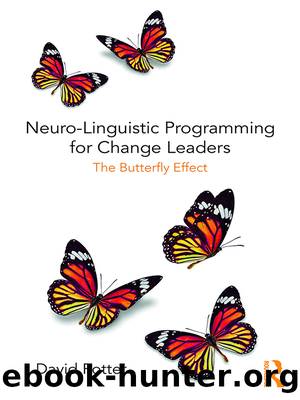Neuro-Linguistic Programming for Change Leaders by David Potter

Author:David Potter [David Potter]
Language: eng
Format: epub
Publisher: Routledge
Published: 2018-05-14T16:00:00+00:00
As an analytical change technique, the SOAR model facilitates reflexivity and sense making regarding:
• The change drivers that have been, are currently or will be active in the environment.
• The type of behaviours that have served the organization well in relation to its environment in the past, in the present and potentially in the future.
• The type of behaviours that have not been resourceful to the organization in relation to its environment in the past, the present and, if allowed, in the future.
• The type of capabilities that have served the organization well in relation to its environment in the past, in the present and potentially in the future.
• The type of capabilities that have not been resourceful to the organization in relation to its environment in the past, the present and, if allowed, in the future.
• The type of beliefs that have served the organization well in relation to its environment in the past, in the present and, potentially, in the future.
• The type of beliefs that have not been resourceful to the organization in relation to its environment in the past, the present and, if allowed, in the future.
• The type of values that have served the organization well in relation to its environment in the past, in the present and, potentially, in the future.
• The type of values that have not been resourceful to the organization in relation to its environment in the past, the present and, if allowed, in the future.
• The type of identities that have served the organization well in relation to its environment in the past, in the represent and, potentially, in the future.
• The type of identities that have not been resourceful to the organization in relation to its environment in the past, the present and, if allowed, in the future.
• The sense of mission that has served the organization well in relation to its environment in the past, in the present and, potentially, in the future.
• The sense of mission that has not been resourceful to the organization in relation to its environment in the past, the present and, if allowed, in the future.
Download
This site does not store any files on its server. We only index and link to content provided by other sites. Please contact the content providers to delete copyright contents if any and email us, we'll remove relevant links or contents immediately.
Hit Refresh by Satya Nadella(9040)
The Compound Effect by Darren Hardy(8817)
Change Your Questions, Change Your Life by Marilee Adams(7637)
Nudge - Improving Decisions about Health, Wealth, and Happiness by Thaler Sunstein(7622)
The Black Swan by Nassim Nicholas Taleb(7016)
Deep Work by Cal Newport(6885)
Daring Greatly by Brene Brown(6449)
Rich Dad Poor Dad by Robert T. Kiyosaki(6413)
Principles: Life and Work by Ray Dalio(6223)
Playing to Win_ How Strategy Really Works by A.G. Lafley & Roger L. Martin(5932)
Man-made Catastrophes and Risk Information Concealment by Dmitry Chernov & Didier Sornette(5924)
Digital Minimalism by Cal Newport;(5667)
Big Magic: Creative Living Beyond Fear by Elizabeth Gilbert(5615)
The Myth of the Strong Leader by Archie Brown(5428)
The Slight Edge by Jeff Olson(5353)
Discipline Equals Freedom by Jocko Willink(5287)
The Motivation Myth by Jeff Haden(5157)
Stone's Rules by Roger Stone(5027)
The Laws of Human Nature by Robert Greene(5001)
